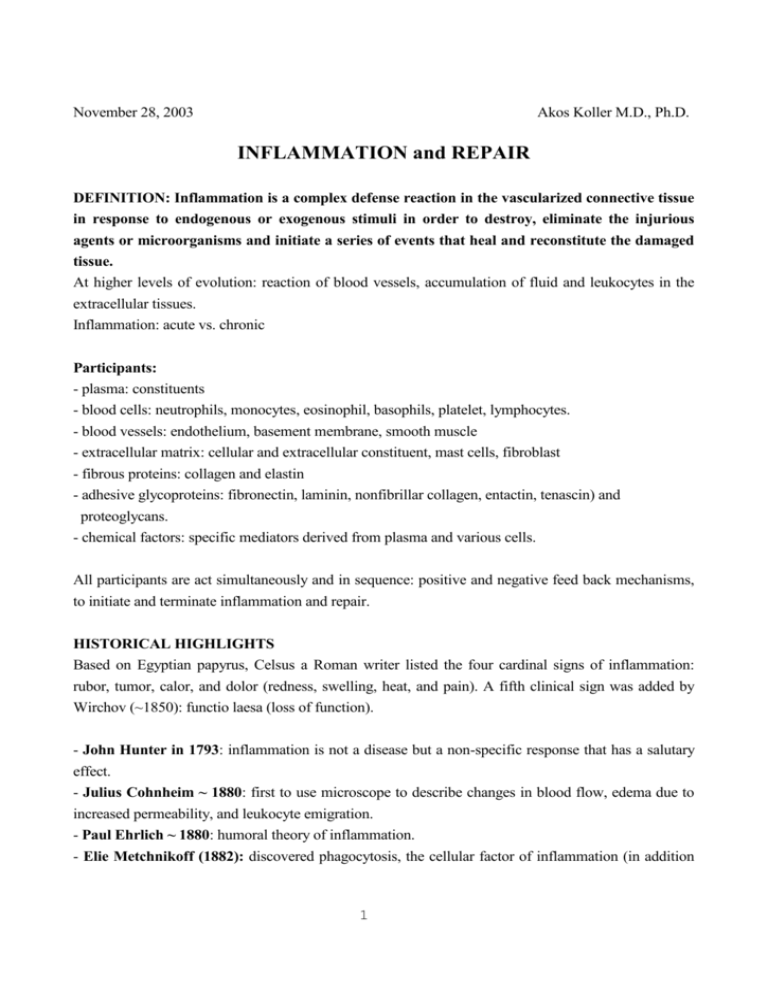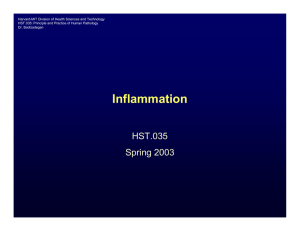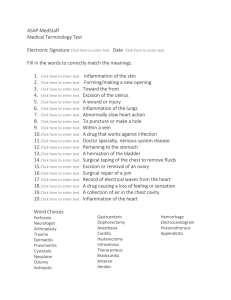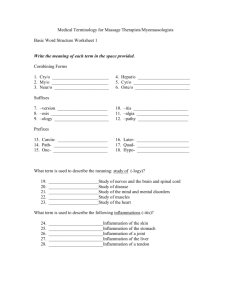April 4, 1998 Akos Koller M
advertisement

November 28, 2003 Akos Koller M.D., Ph.D. INFLAMMATION and REPAIR DEFINITION: Inflammation is a complex defense reaction in the vascularized connective tissue in response to endogenous or exogenous stimuli in order to destroy, eliminate the injurious agents or microorganisms and initiate a series of events that heal and reconstitute the damaged tissue. At higher levels of evolution: reaction of blood vessels, accumulation of fluid and leukocytes in the extracellular tissues. Inflammation: acute vs. chronic Participants: - plasma: constituents - blood cells: neutrophils, monocytes, eosinophil, basophils, platelet, lymphocytes. - blood vessels: endothelium, basement membrane, smooth muscle - extracellular matrix: cellular and extracellular constituent, mast cells, fibroblast - fibrous proteins: collagen and elastin - adhesive glycoproteins: fibronectin, laminin, nonfibrillar collagen, entactin, tenascin) and proteoglycans. - chemical factors: specific mediators derived from plasma and various cells. All participants are act simultaneously and in sequence: positive and negative feed back mechanisms, to initiate and terminate inflammation and repair. HISTORICAL HIGHLIGHTS Based on Egyptian papyrus, Celsus a Roman writer listed the four cardinal signs of inflammation: rubor, tumor, calor, and dolor (redness, swelling, heat, and pain). A fifth clinical sign was added by Wirchov (~1850): functio laesa (loss of function). - John Hunter in 1793: inflammation is not a disease but a non-specific response that has a salutary effect. - Julius Cohnheim ~ 1880: first to use microscope to describe changes in blood flow, edema due to increased permeability, and leukocyte emigration. - Paul Ehrlich ~ 1880: humoral theory of inflammation. - Elie Metchnikoff (1882): discovered phagocytosis, the cellular factor of inflammation (in addition 1 to the already known serum factors). Win Nobel Prize with Paul Ehrlich in 1908. - Sir Thomas Lewis: concept of local chemical substances, such as histamine mediates vascular changes of inflammation (potential use of anti-inflammatory agents). I. ACUTE INFLAMMATION Immediate and early response (15-30 min): major role for vascular phenomena (antibodies and leukocytes). Most of these events take place in the postcapillary venules! Three major components: 1.) alterations in vascular diameter: changes in blood flow 2.) change in vascular wall structure: changes in permeability 3.) cellular events: emigration of leukocytes (margination, rolling, adhesion, then migration into the interstitium and accumulation at site of injury). Terms: exudate, transudate, edema, pus (purulent exudate). 1) Vascular Changes - Changes in diameter and flow: transient vasoconstriction, followed by vasodilation and opening of capillaries eliciting increases in blood flow. - slowing of the circulation (due to increased permeability, increased hematocrit, viscosity) leading to stasis. 2) Increased vascular permeability - escape of protein rich fluid (exudate) into the interstitium. The reduced intravascular osmotic pressure and increased hydrostatic pressure (due to vasodilation) lead to marked outflow of fluids (substances and cells): edema. Mechanisms of endothelial/vascular leakage: a) endothelial cell contraction: widened intercellular junctions elicited by histamine, bradykinin, leukotrienes etc. effect primarily venules (20-60 um) immediate response (~20 min). b) cytoskeletal and junctional reorganization: endothelial retraction induced by cytokines, interleukin 1 (IL-1), tumor necrosis factor (TNF), interferon-gamma (IFN-g). Delayed response (4-6 h). c) direct endothelial injury necrosis, detachment, platelet adhesion (burns, lytic bacterial infections), "immediate sustained response" and last until thrombosis or repair. All participants of microcirculation are affected. "delayed prolonged response (2-12 h): X or UV-radiation sunburns, toxins, eliciting damage and apoptosis of endothelial cells. 2 d) leukocyte-mediated endothelial injury: releasing toxic oxygen species, proteolytic enzymes e) leakage from regenerating capillaries: angiogenesis, the capillary sprouts remain leaky until the endothelial cells form intercellular junctions. f) increased transcytosis via vesicles and vacuoles across the cytoplasm. All of these events may play role in response to one stimulus. 3) Cellular Events Emigration of leukocytes: 1) margination, rolling, adhesion, then 2) migration into the interstitium and 3) accumulation at site of injury toward chemotactic stimulus. Modulated by: - hemodynamic factors! - binding of complementary adhesion molecules on the leukocyte and endothelial surfaces - surface expression and avidity of adhesion molecules Receptors on various cells: 1) Selectins: extracellular N-terminal domain-lectin-oligosaccharides (sialylated Lewis X). Types: E(endothelial)-, P(platelets)-, L(leukocytes)-selectins. 2) Immunoglobulins: two endothelial adhesion molecules interact with integrins: - intercellular adhesion molecules (ICAM-1), - vascular cell adhesion molecules (VCAM-1). 3) Integrins: on the surface of leukocytes, transmembrane adhesive glycoproteins (a and b chains) function as receptors for the extracellular matrix (ECM). - b2-integrins (LFA-1 and MAC-1) receptor for ICAM-1. - b1-integrins (VLA-4) receptor for VCAM-1. Modulations (activation) of these molecules induce adhesion: 1. Redistribution of adhesion molecules to the surface P-selectins in endothelial granules (WeibelPalade bodies) on stimulation by histamine, thrombin, PAF: role in eliciting rolling 2. Induction of adhesion molecules (synthesis and surface expression) 3. Increased activity of bindings to the binding of integrins, from state of low to high affinity binding toward ICAM-1. 3 Transmigration to the basement membrane then collagenases degrade basement membrane. Neutrophils emigrate in the first 6-12h and monocytes in the 24-48h. Chemotaxis and leukocyte activation chemotaxis: movements oriented along a chemical gradient chemoattractant: elicits chemotaxis 1. exogenous: bacterial products, peptides, lipids 2. endogenous: a. components of the complements system b. products of the lipoxygenase pathway c. cytokines Binding of chemotactic agents to the cell membrane initiate: 1. activation of phospholipase C IP3 DAG release of Ca2+ intracellular ---> contractile movements, extending pseudopodium (filaments - actin - myosin complexes.) 2. leukocyte activation (priming by TNF) - production of AA metabolites - degranulation and secretion of lysosomal enzymes - activation of oxidative burst - modulation of leukocytes adhesion molecules Phagocytosis - recognition and attachment: if microorganisms are coated with opsonin (Fc fragment of IgG and C3b, which binds to specific receptors (FcyR) on leukocytes (also there is non opsonic phagocytosis), then - engulfment: extension of the cytoplasm flow around the object then the two membrane fuses then discharge the contents of granules into the phagolysosome - killing or degradation: oxygen dependent mechanisms, burst in oxygen consumption, generation of ROM, myeloperoxidase and halide produces Cl- converts H2O2 to HOCl., and bactericidal permeability increasing protein (BPI), lysozyme, lactoferrin, defensins. - after killing acid hydrolases degrade the bacteria in the phagolysosome at pH between ~ 4 -5. Release of Leukocyte Products - phagocytic vacuole remains open, regurgitation or - frustrated phagocytosis, cytotoxic release, - secretion by exocytosis. 4 Substances: - enzymes - oxygen derived free radicals - AA metabolites Defects in Leukocyte Function Deficiencies in: - leukocytes adhesion molecules (LAD) types 1 and 2 - in NADPH oxidase (CGD). - defective degranulation and delayed microbial killing: Chediak - Higashi syndrome CHEMICAL MEDIATORS OF INFLAMMATION They account for various events and: - released from plasma or cells - are in precursor form - are sequestered - or synthesized de novo - bind to specific receptors on target cells stimulate the release of other mediators - short-lived - may be harmful Vasoactive Amines: Histamine: - released from mast cells, basophils, platelets - to: physical injury, immune reactions, fragments of complement proteins from L, neuropeptides (SP), cytokines - elicits: dilation of arterioles, increase permeability (by endothelial contraction), acts on H1 receptors. Serotonin: - released from platelets (when aggregates), mast cells (IgE mediated), contact with collagen, ADP, thrombin, PAF, Ag-Ab. Plasma Proteases: Three inter-related plasma derived systems: 5 1) The Complement System 20 component proteins in plasma Culminating in producing membrane attack complex (MAC): lysis of microbes. During this process number of components is produced that cause: increase permeability, chemotaxis, and opsonization. Present in inactive forms in plasma: C1 through C9. - Critical step: activation of the C3 - by the classic pathway: fixation of C1 to antibody (IgM and IgG) combined with antigen, - by alternative pathway: triggered by microbial surface endotoxins, and by proteolytic enzymes (plasmin, lysosomal enzymes). All of these result in that: C3 convertase splits C3 to C3a and C3b fragments that are released. C3b binds to fragments to form C5 convertase which interacts with C% to release C5a and initiate the assembly of the MAC (C5-C9 complex) which forming transmembrane channels eliciting lysis of microbes. Complement derived factors affect a variety of phenomena associated with inflammation: - Vascular C3a and C5a increase permeability and diameter and activates AA metabolism, and promote chemotaxis. - Leukocyte: adhesion, activation, chemotaxis, activates surface integrins - Phagocytosis: C3b act as opsonin which is a receptor for leukocytes and macrophages 2) The Kinin System Triggered by contact activation (negative charges) of Hageman factor (XII). The end result of cascade: release of bradykinin which elicits dilation, increases in permeability, and pain. XIIa converts plasma prekallikrein into active kallikrein, which cleaves high molecular weightkininogen (HMWK) to produce bradykinin. Short-lived, because degraded by kininase. Kallikrein activates XII factor and converts C5 to C5a amplifying the initial stimulus. 3) The Clotting System Activated by Hageman factor, end: fibrinogen fibrin conversion by the action of thrombin. - Thrombin induces leukocyte adhesion and fibroblast proliferation. - Fibrinolytic system: plasminogen activator ---> plasminogen ---> plasmin Lysing fibrin clots and cleaves C3 to C3 fragments and degrades fibrin to "fibrin degradation products", which increase permeability. Arachidonic Acid Metabolites: AA is a polyunsaturated fatty acid, present in esterified form in the membrane phospholipids. Released by activation of phospholipases by mechanical and chemical stimuli. 6 - AA metabolites: eicosanoids: affect and mediate inflammation and hemostasis (etc). - local, short-range, short-lived hormones 1. Prostaglandins produced by cyclooxygenase pathway: PGE2, PGI2 PGD2 and TxA2 (find in platelets, inactive form TxB2). - increase diameter and permeability, except TxA2 which is constrict. - inhibitor of COX: aspirin, indomethacin, NSAID. 2. Leukotrienes Produced by the lipoxygenase pathway. 5-lipoxygenase is found in neutrophils 5-HETE which is chemotactic for neutrophil is converted to leukotrienes LTB4, LTC4, LTD4 and LTE4 vasoconstrictors, induce aggregations, adhesions. Platelet-Activating Factor: PAF: another phospholipid mediator elicits multiple inflammatory effects. - stimulation of platelets - vasoconstriction - permeability increases Cytokines: In response to various stimuli (endotoxins, injury immune complexes) polypeptides produced by activated lymphocytes and macrophages that modulates the function of other cell types. CK involved in cellular immune and inflammatory response: IL-1, TNF (a and b) and the IL-8 family. - autocrine, paracrine and endocrine effects on endothelium, leukocytes and fibroblast. - induce gene transcription and synthesis of adhesion molecules, growth factors, PGs and NO. - TNF induces aggregation and priming of leukocytes - IL-8: powerful chemoattractant and activator of neutrophils, inducer of other cytokines - IL-1 and TNF induce systemic acute-phase reaction (fever, slow wave sleep, release of leukocytes into the circulation and ACTH, septic shock, and process of repair) Nitric Oxide (NO): endothelium-derived relaxing factor: NO, ?? L-arginine, oxygen and NADPH, + nitric oxide synthase: NO - in vivo half-life is 6 sec - increases cGMP which elicits relaxation of vascular smooth muscle relaxation, inhibit platelets aggregation and adhesion, toxic free radical to microbes, with superoxide form strong oxidant: nitrogen dioxide and hydroxyl radical. 7 - constitutive NOS (Ca2+ and calmodulin are needed) endothelium and neurons - induced NOS (Ca2+ is not needed) in macrophages by cytokines. - too much NO ---> vasodilation, septic shock <-- use of inhibitors such as L-NNA. Lysosomal Constituents of Leukocytes: - smaller specific (or secondary) granules contain: lactoferrin, lysosome, alkaline phosphatase, components of NADPH oxidase, integrins, and collagenase. They are secreted readily, to lower conc. of agonists. - large azurophil (or primary) granules contain: MPO, bactericidal factors, acid hydrolases, neutral proteases (elastase, proteinase and collagenase): more destructive, found in phagosomes and require higher conc. of agonist or stimulation or after cell death. - Acid proteases degrade bacteria within the phagosome at low pH. - Neutral proteases work on extracellular components and cleave C3 and C5 directly releasing anaphylatoxins and kinins. - Hydrolases, collagenase, elastase, plasminogen activator in macrophage and monocytes Balance: The harmful proteases are inhibited by a1-antitrypsin and a2-macroglobulin. Oxygen-derived free radicals/species: Released extracellularly from leukocytes after activation: Superoxide, H2O2, OH.; NO, PON, etc. They involved in: - endothelial damage and increased permeability - inactivation of antiproteases - injury to other cells Antioxidant protective mechanisms detoxify these radicals: - ceruloplasmin, transferrin, SOD, catalase, glutathione peroxidase, Balance: between production and elimination of radicals. Other mediators: - Neuropeptides: such as substance P--> vasodilation and increase permeability and release of histamine, PGs by mast cells and NO by endothelium. - Growth factors: PDGF, TGF-b, ECM components and their fragments chemotactic and other activities 8 OUTCOMES OF ACUTE INFLAMMATION 1. complete resolution 2. healing by connective tissue replacements 3. abscess formation 4. chronic inflammation II. CHRONIC INFLAMMATION DEFINITION: Inflammation of prolonged duration (weeks, months) in which active inflammation, tissue destruction and attempts at healing are proceeding simultaneously. Examples: rheumatoid arthritis, atherosclerosis, tuberculosis and chronic lung diseases. Causes: - persistent infection - prolonged exposure to toxic agents - immune reactions against the individual’s own tissues, leading to autoimmune diseases (LE, RA, TB, etc.) Main characteristics: 1. infiltration with mononuclear cells, macrophages (mononuclear phagocyte system: MPS), lymphocytes, plasma cells. Reflection of persistent reaction to injury. 2. tissue destruction, 3. attempts to repair by connective tissues (fibrosis) 4. proliferation of blood vessels, angiogenesis Maintenance of presence of monocytes/macrophages: 1) continued recruitment 2) local proliferation 3) immobilization Lymphocytes and plasma cells 9 LYMPHATICS IN INFLAMMATION Lymphatics and lymph nodes filters extravascular fluids, together with the mononuclear phagocyte system represent the second line of defense. - thin endothelial tubes, overlapping loose cell junction, no muscular layer, valve - drain edema from extracellular space - lymphangitis, lymphadenitis The next (and final) line of defense: liver, spleen, bone marrow, if not: endocarditis, meningitis, renal abscesses and septic arthritis can develop. MORPHOLOGICAL PATTERNS OF ACUTE AND CHRONIC INFLAMMATION - Serous inflammation - Fibrinous inflammation - Suppurative or purulent inflammation - Ulcers SYSTEMIC EFFECTS OF INFLAMMATION - acute-phase reaction: fever, slow wave sleep, release of leukocytes into the circulation, ACTH, and septic shock, - leukocytosis - leukemoid reaction, shift to the left, IL-1 and TNF stimulate colony stimulating factor (CSF) of hemopoietic precursors cells - lymphocytosis, eosinophilia, mononucleosis, etc. III. WOUND HEALING / REPARATIVE RESPONSE 1. primary union or healing by first intention, 2. secondary union or healing by second intention, due to the presence of large tissue defect, more necrotic debris and exudate, hence more intense inflammatory reaction. b. large amount of granulomatous tissue are formed c. wound contraction (myofibroblast) Main players: Collagen is the most common protein providing the frame work for all multicellular organisms. There are 14-types of collagen, the cross-linking of fibrils give the tensile strength. 10 - Collagen synthesis by fibroblasts Synthesis and degradation (metalloproteinases, collagenases) First: fibroplasia, then tissue remodeling and scarring. - Wound strength: increases slowly, day by day: first week 10% to third months 70-80% of the original strength. - Pathologic aspects of repair: keloid, granulation tissue, desmoids, fibromatoses File name: inflamtext20031128 11











